- Tomcat安装测试、Eclipse配置Tomcat步骤
- 基于Django的电影推荐系统设计与实现
- Python爬虫入门(一)(适合初学者)
- 成功上岸最新Go面经:百度滴滴小米360小红书展盟优咔科技......
- 电影Top250数据分析可视化,应用Python爬虫,Flask框架,
- Spring AOP入门指南:轻松掌握面向切面编程的基础知识
- Springboot MyBatis实现多数据源切换和主从复制(读写分
- Spring Boot @Autowired注入为空的原因及解决方法
- springboot:时间格式化的5种方法(解决后端传给前端的时间格式
- 如何升级npm 和 安装nvm 及 升级node.js
- 【项目实战】Kafka中Topic创建介绍
- 【Golang】排查 Build constraints exclud
- 基于PHP和MySQL的新闻发布系统——【功能优化】
- (python3爬虫二)Linux安装谷歌浏览器以及对应版本驱动程序
- 基于Java+SpringBoot制作一个社区宠物登记小程序
- MySQL之触发器
- 手把手教你JAVA如何连接MYSQL-mysql-connector-
- nvm管理node 无法正常切换node版本问题
- Spring:Bean
- Django REST Framework完整教程-认证与权限-JWT
- Spring Boot动态设置定时任务
- 大华摄像头实时预览(spring boot+websocket+flv
- SpringSecurity6从入门到上天系列第九篇:SpringSe
- C - 语言->内存函数
- Flask三种文件下载方法
- SpringBoot对接小程序微信支付
- Nginx 【location配置路径详解、反向代理、负载均衡】
- 基于Python + Django 开发一款学生管理系统(附源码)
- 基于JavaWeb+MySQL的企业员工信息管理系统(考勤、工资、岗位
- Django提示mysql版本过低:django.db.utils.N
文章目录
- 一、项目进行多环境配置的必要性
- 二、使用Profile文件进行多环境配置
- (一)创建Spring Boot项目
- (二)创建多环境配置文件
- 1、全局配置文件改名
- 2、模拟开发环境
- 3、模拟测试环境
- 4、模拟生产环境
- (三)创建控制器
- (四)采用默认环境
- (五)指定使用环境
- 方式1、使用配置文件全局指定使用环境
- (1) 在全局配置文件里指定当前使用环境 - 开发环境
- (2) 在全局配置文件里指定当前使用环境 - 测试环境
- (3) 在全局配置文件里指定当前使用环境 - 生产环境
- 方式2、通过命令行方式指定使用环境
- (1)使用IDEA将Maven项目打成jar包
- (2)在终端执行jar包,选择使用环境 - 开发环境
- (3)在终端执行jar包,选择使用环境 - 测试环境
- (4)在终端执行jar包,选择使用环境 - 生产环境
- 三、使用@Profile注解进行多环境配置
- (一)创建Spring Boot项目ProfileDemo02
- (二)创建数据库配置接口DatabaseConfig
- (三)创建三个数据库配置实现类
- 1、创建数据库配置实现类MySQLConfig
- 2、创建数据库配置实现类OracleConfig
- 3、创建数据库配置实现类SybaseConfig
- (四)在全局配置文件里设置使用环境
- (五)打开测试类,编写测试方法
- (六)运行测试方法,查看结果
- 练习
- 1、设置使用环境 - MySQL数据库环境,并测试
- 2、设置使用环境 - Sybase数据库环境,并测试
- 四、随机值设置以及参数间引用
- (一)创建Spring Boot Web项目RandomSetDemo
- (二)在全局配置文件里配置随机值
- (三)在测试类里测试配置的随机数
- 1、测试随机数my.number
- 2、测试随机整数my.integer
- 练习
- 1、测试长整型随机数my.long
- 2、测试随机UUID值my.uuid
- 3、测试小于10的随机整数my.number.less
- 4、测试1024至65535之间的随机整数my.number.range
- (四)演示参数间的引用
一、项目进行多环境配置的必要性
在实际开发中,应用程序通常需要部署到不同的运行环境中,例如开发环境、测试环境、生产环境等。不同的环境可能需要不同的环境配置,针对这种情况,不可能手动变更配置文件来适应不同的开发环境,通常需要对项目进行多环境配置,Spring Boot框架提供了两种多环境配置的方式,分别是Profile文件多环境配置和@Profile注解多环境配置。同时,会额外讲解在Spring Boot配置文件中设置属性时,除了可以像前面示例中显示的配置属性值外,还可以使用随机值和参数间引用对属性值进行设置。
二、使用Profile文件进行多环境配置
(一)创建Spring Boot项目
使用Spring Initializr模板创建Spring Boot项目——ProfileDemo01,配置好后,单击【Next】按钮
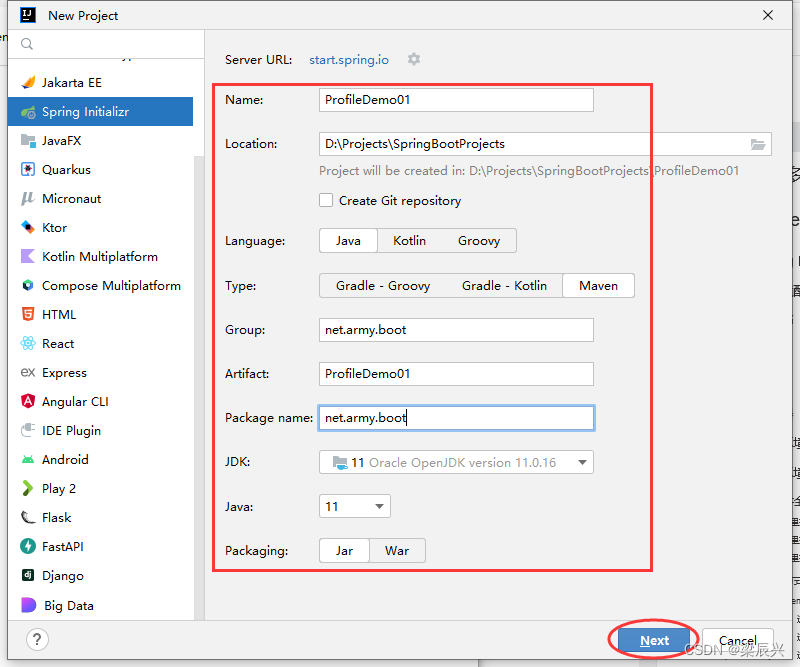
选择Spring Boot版本,添加相关依赖
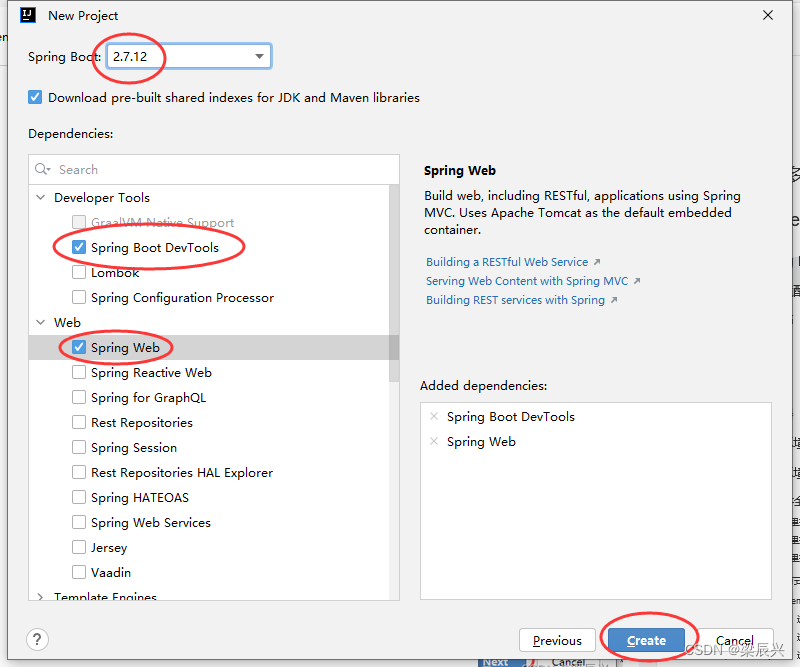
单击【Create】按钮
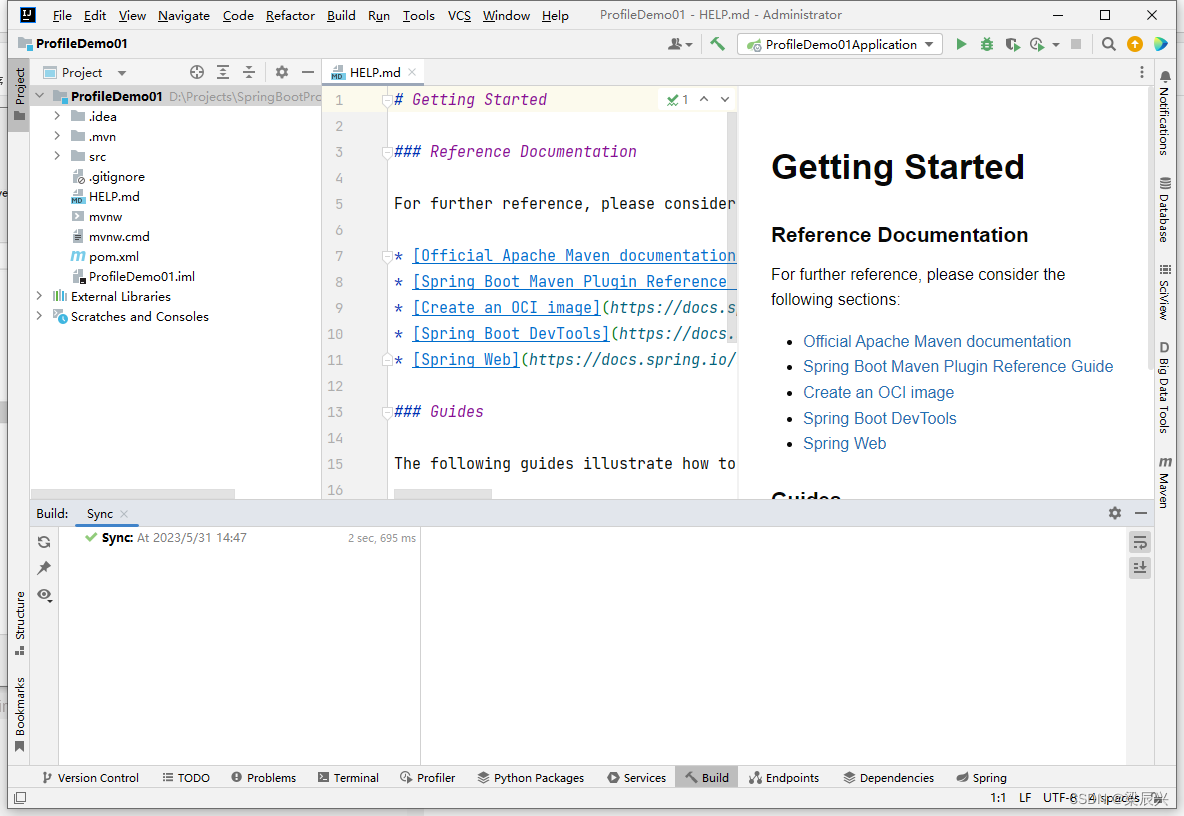
(二)创建多环境配置文件
配置文件命名格式:application-xxx.yaml
此例仅演示端口号与虚拟路径的配置,实际应用中可以配置许多内容
1、全局配置文件改名
将application.properties更名为application.yaml
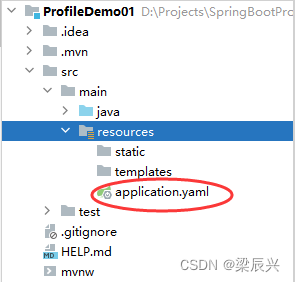
2、模拟开发环境
在resources里创建配置文件 - application-dev.yaml
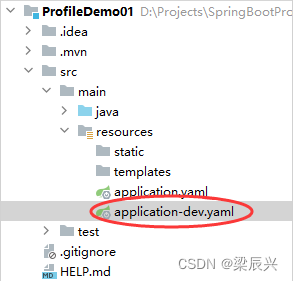
# 配置服务器 server: port: 8081 servlet: context-path: /lzy013、模拟测试环境
在resources里创建配置文件 - application-test.yaml
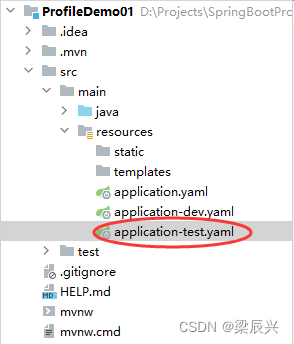
# 配置服务器 server: port: 8082 servlet: context-path: /lzy024、模拟生产环境
在resources里创建配置文件 - application-prod.yaml
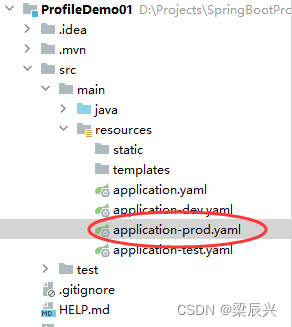
# 配置服务器 server: port: 8083 servlet: context-path: /lzy03(三)创建控制器
在net.army.boot包里创建controller子包,在子包里创建ProfileController类
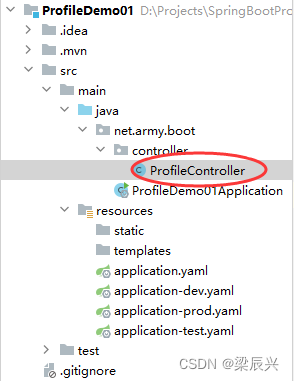
package net.army.boot.controller; import org.springframework.web.bind.annotation.GetMapping; import org.springframework.web.bind.annotation.RestController; /** * 作者:梁辰兴 * 日期:2023/5/31 * 功能:概况控制器 */ @RestController public class ProfileController { @GetMapping("/welcome") public String welcome() { return "欢迎访问Spring Boot世界~
"; } }(四)采用默认环境
默认采用配置文件application.yaml,启动服务器,访问:http://localhost:8080/welcome

(五)指定使用环境
方式1、使用配置文件全局指定使用环境
(1) 在全局配置文件里指定当前使用环境 - 开发环境
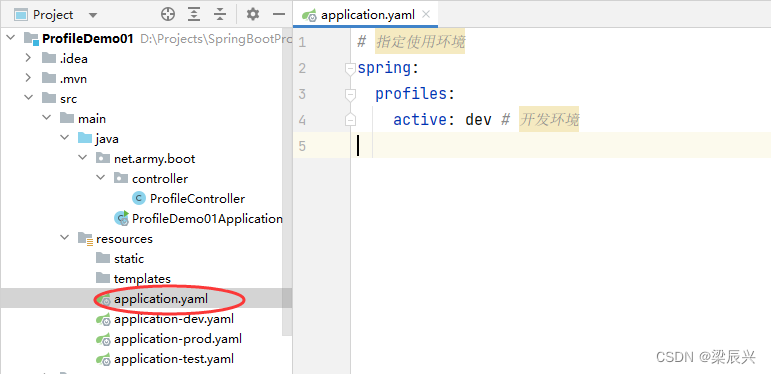
spring: profiles: active: dev,表明当前生效的环境配置文件是application-dev.yaml
启动项目,查看采用的使用环境:服务器端口号与虚拟路径
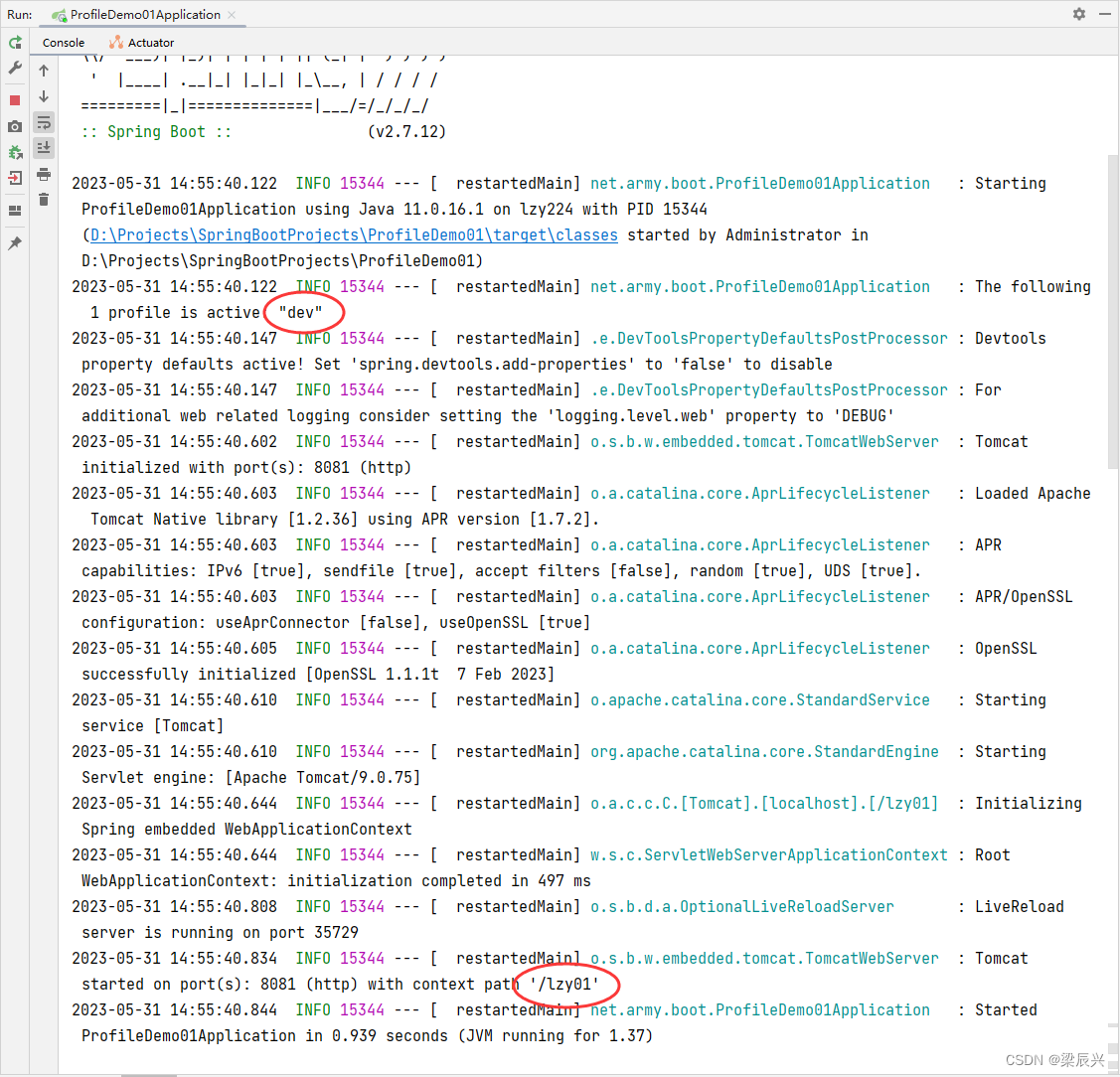
访问:http://localhost:8081/lzy01/welcome

(2) 在全局配置文件里指定当前使用环境 - 测试环境
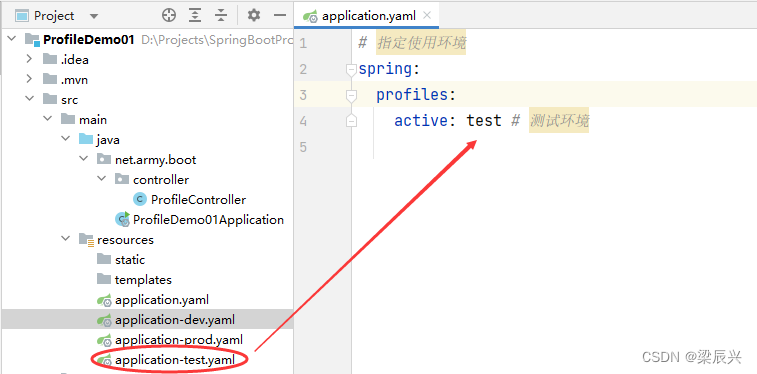
spring: profiles: active: test,表明当前生效的环境配置文件是application-test.yaml
启动项目,查看采用的使用环境:服务器端口号与虚拟路径
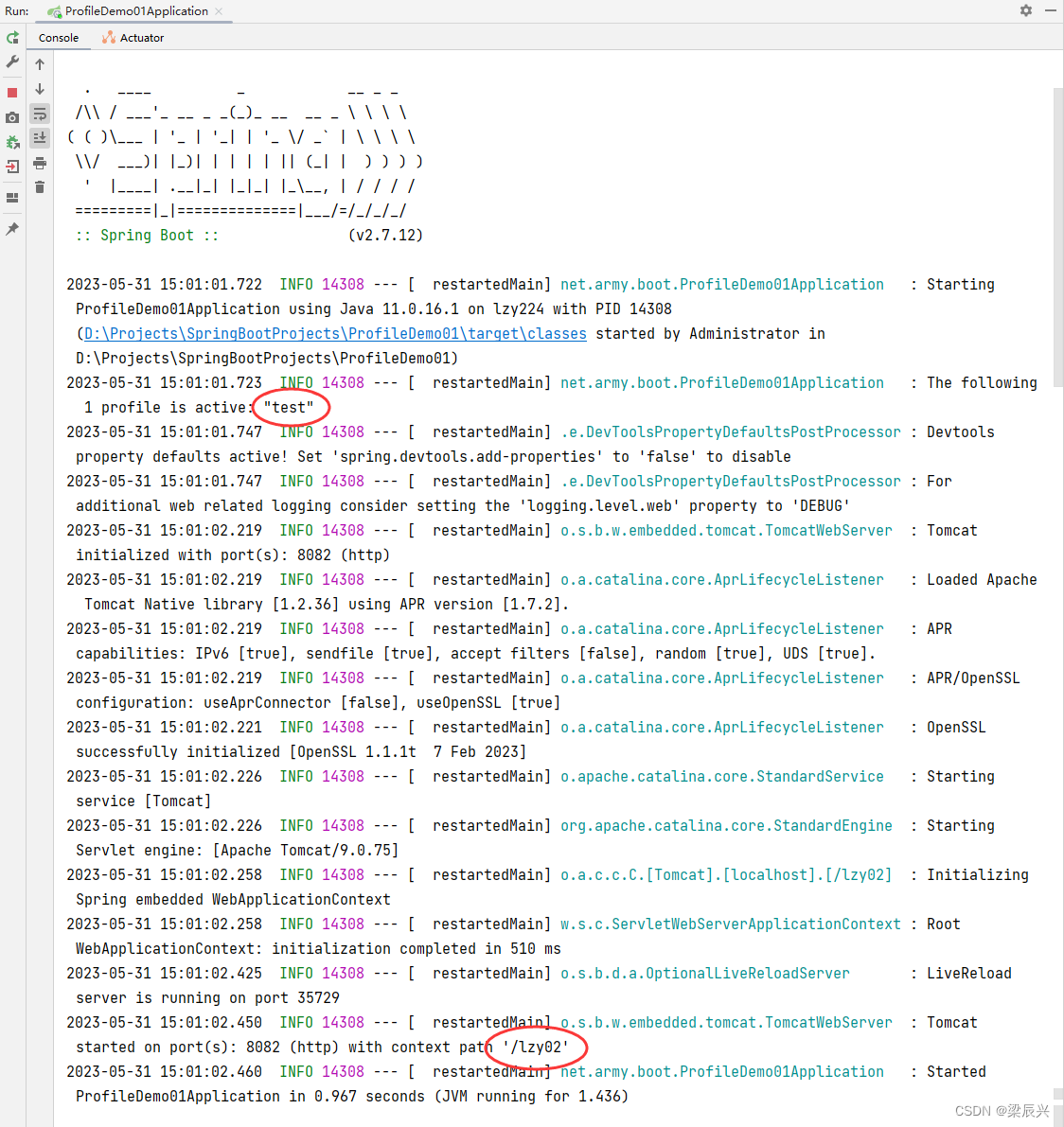
访问:http://localhost:8082/lzy02/welcome

(3) 在全局配置文件里指定当前使用环境 - 生产环境
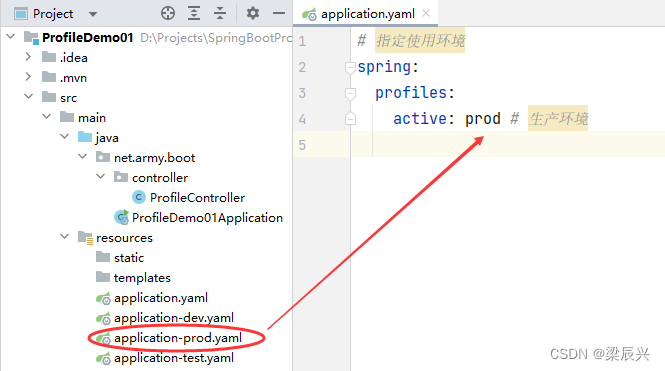
spring: profiles: active: prod,表明当前生效的环境配置文件是application-prod.yaml
启动项目,查看采用的使用环境:服务器端口号与虚拟路径
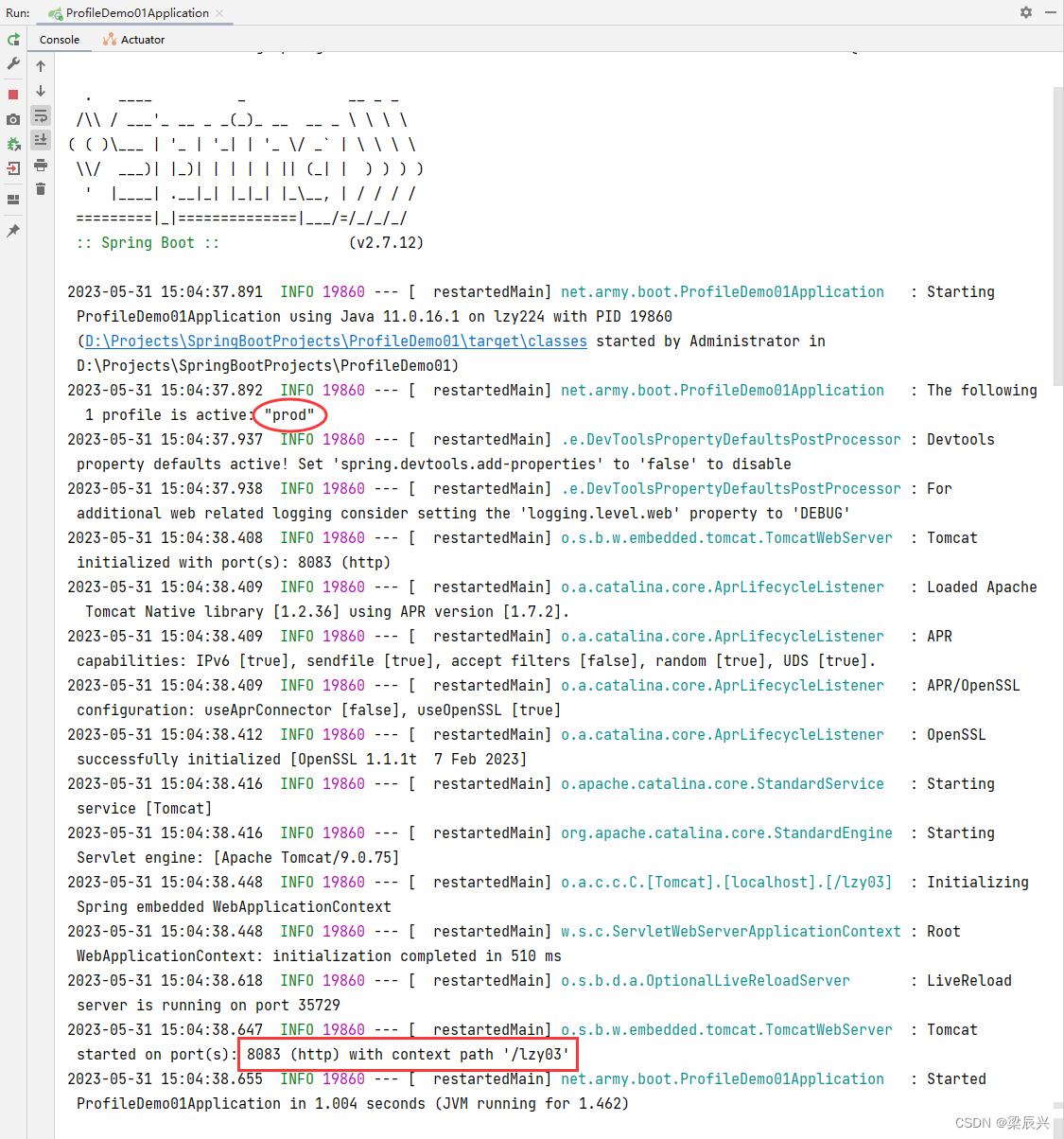
访问:http://localhost:8083/lzy03/welcome

方式2、通过命令行方式指定使用环境
(1)使用IDEA将Maven项目打成jar包
Maven - ProfileDemo01 - LifeCycle - package,单击右键,在快捷菜单里执行“Run Maven Build”
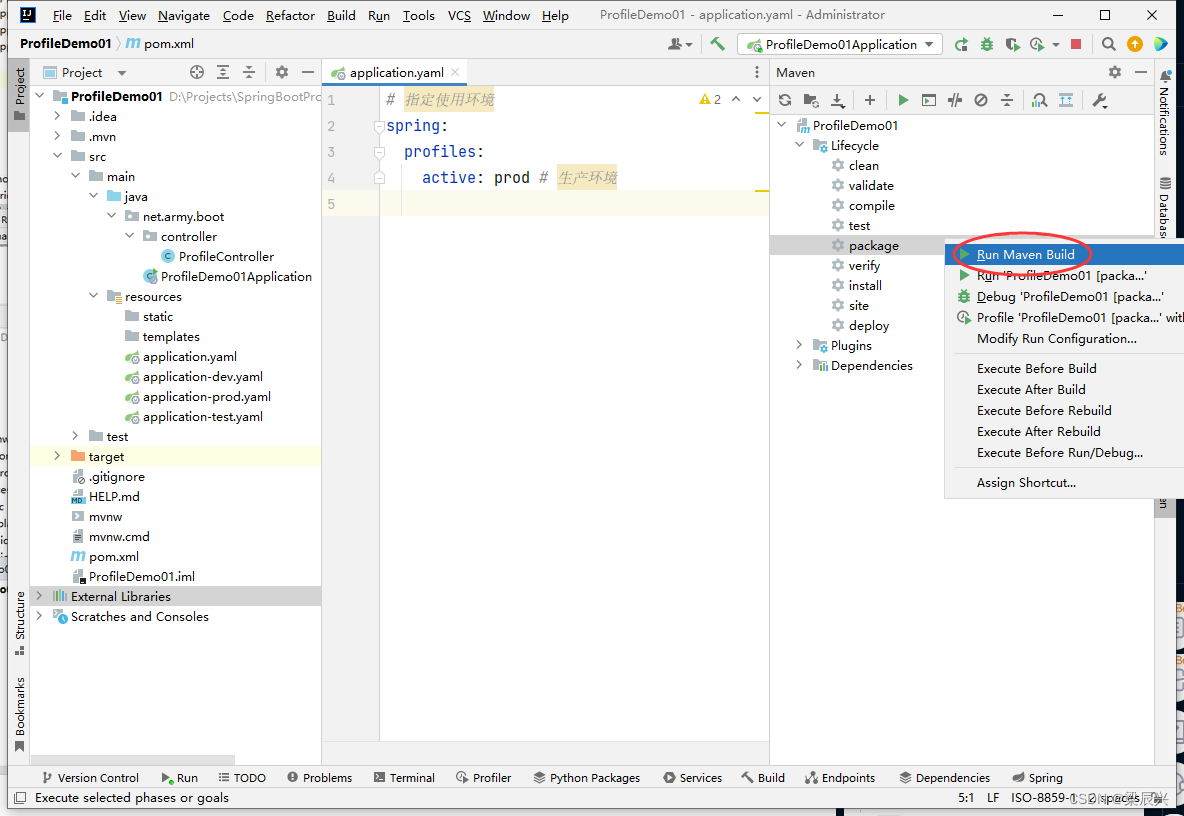
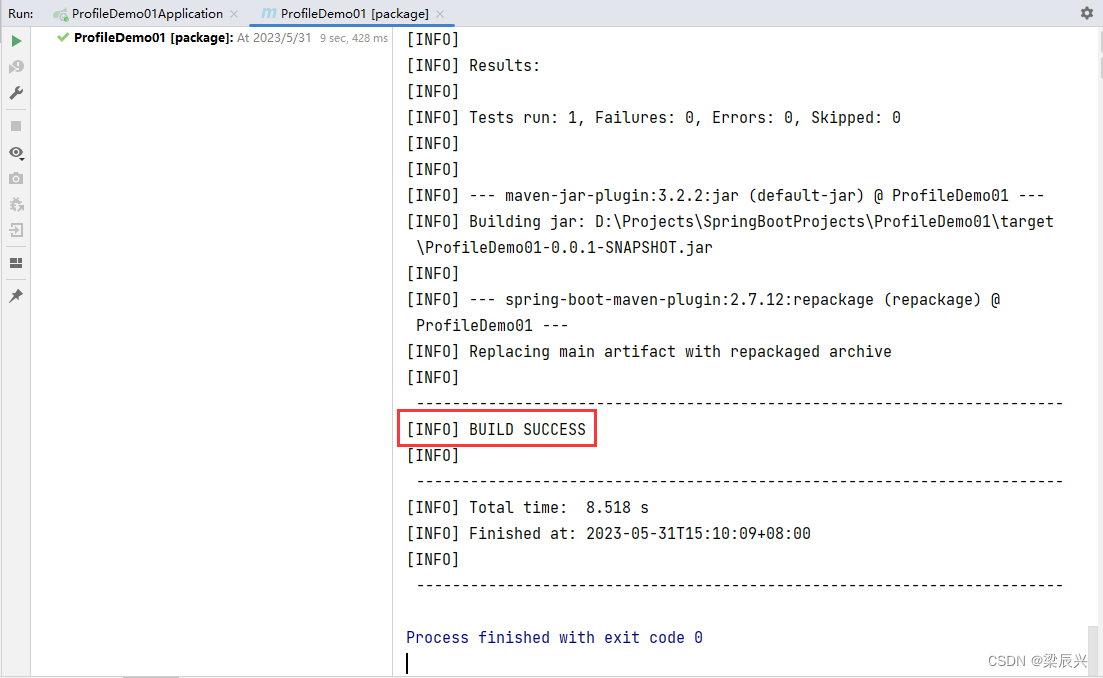
(2)在终端执行jar包,选择使用环境 - 开发环境
D:\Projects\SpringBootProjects\ProfileDemo01> cd target D:\Projects\SpringBootProjects\ProfileDemo01\target> java -jar ProfileDemo01-0.0.1-SNAPSHOT.jar --spring.profiles.active=dev
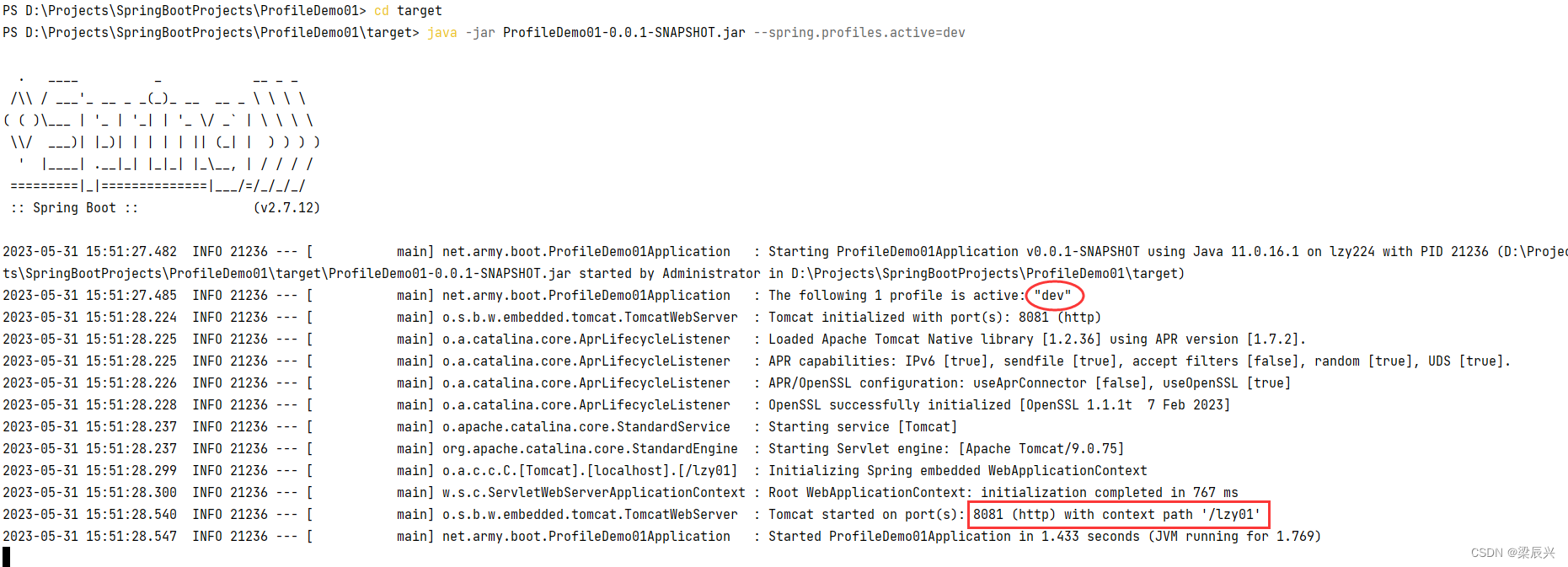
(3)在终端执行jar包,选择使用环境 - 测试环境
D:\Projects\SpringBootProjects\ProfileDemo01> cd target D:\Projects\SpringBootProjects\ProfileDemo01\target> java -jar ProfileDemo01-0.0.1-SNAPSHOT.jar --spring.profiles.active=test

(4)在终端执行jar包,选择使用环境 - 生产环境
D:\Projects\SpringBootProjects\ProfileDemo01> cd target D:\Projects\SpringBootProjects\ProfileDemo01\target> java -jar ProfileDemo01-0.0.1-SNAPSHOT.jar --spring.profiles.active=prod
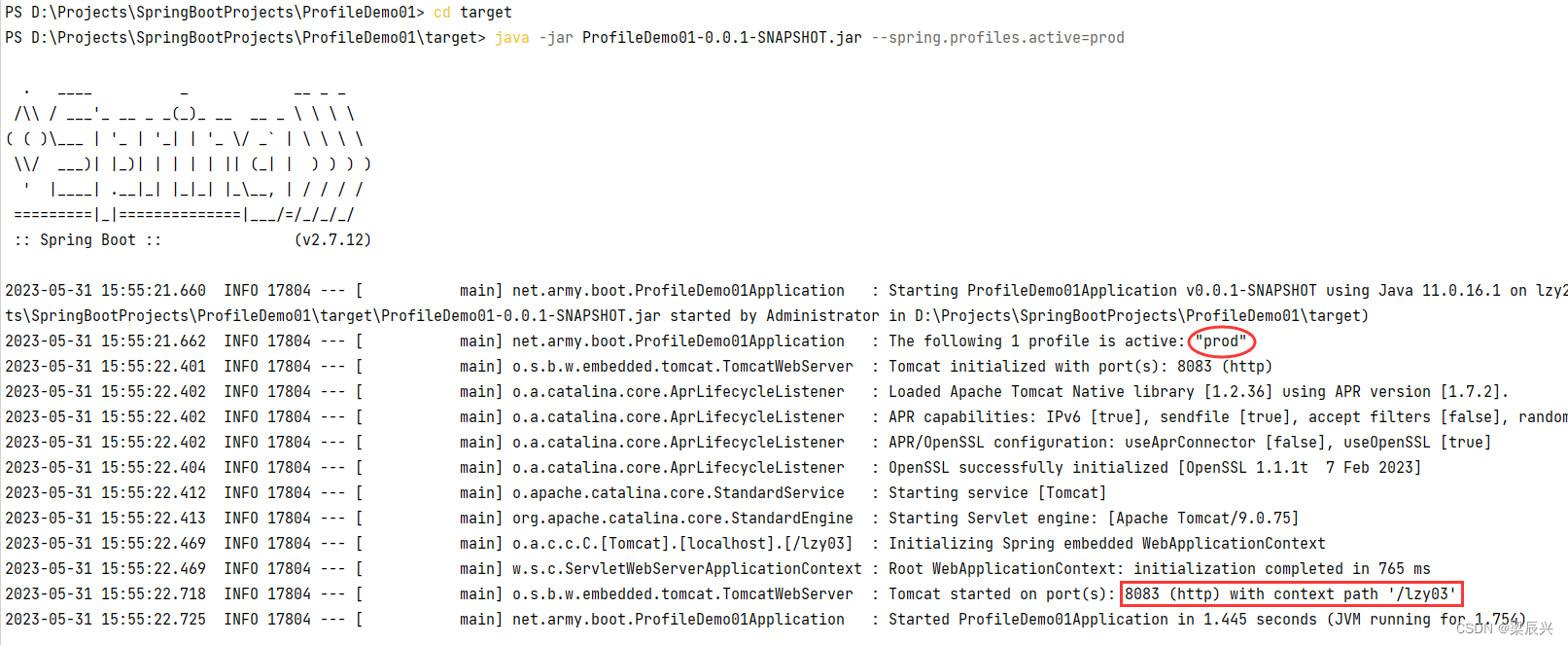
三、使用@Profile注解进行多环境配置
如果项目可能用到三种不同的数据库环境,比如MySQL、Oracle和Sybase,那么我们如何利用@Profile注解来实现多数据库环境配置呢?
(一)创建Spring Boot项目ProfileDemo02
使用Spring Initializr模板创建Spring Boot项目——ProfileDemo02,配置好后,单击【Next】按钮
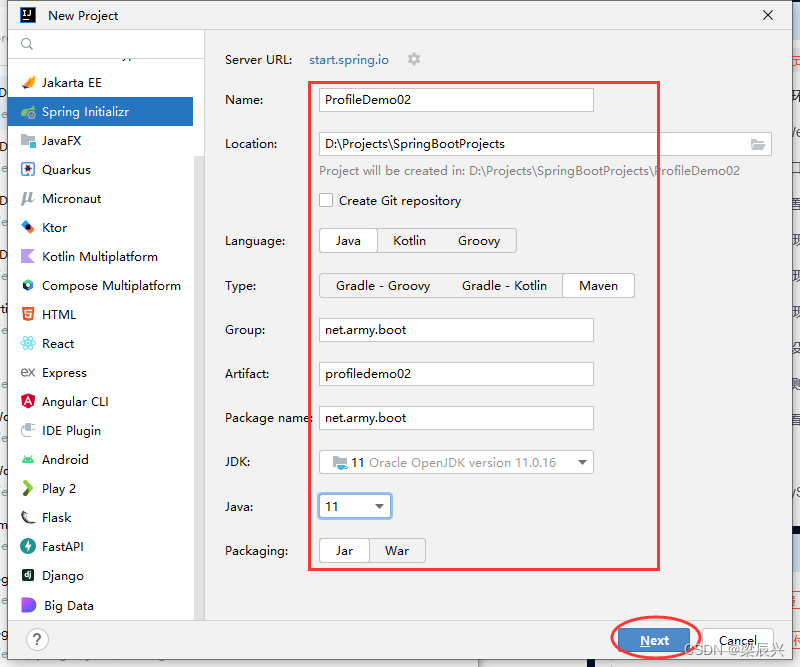 选择Spring Boot版本,添加相关依赖
选择Spring Boot版本,添加相关依赖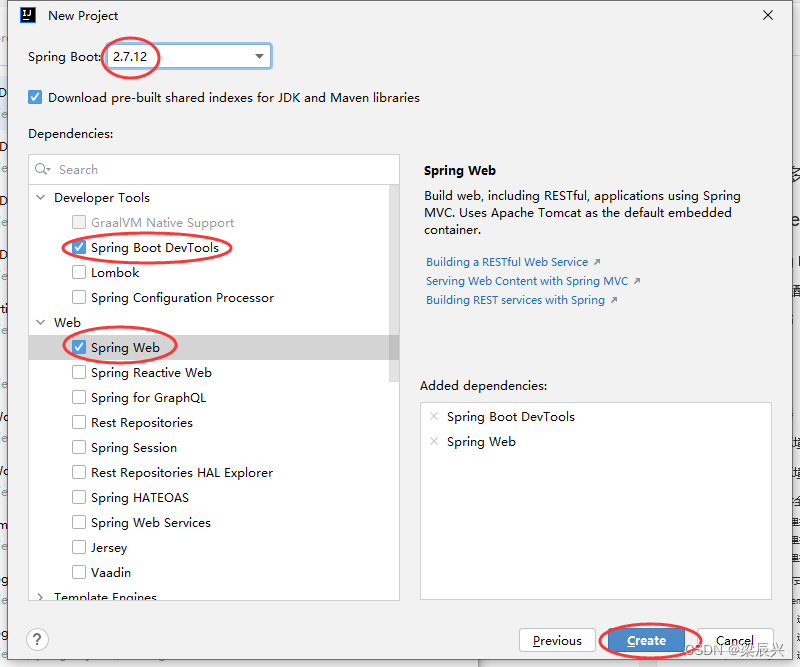
单击【Create】按钮
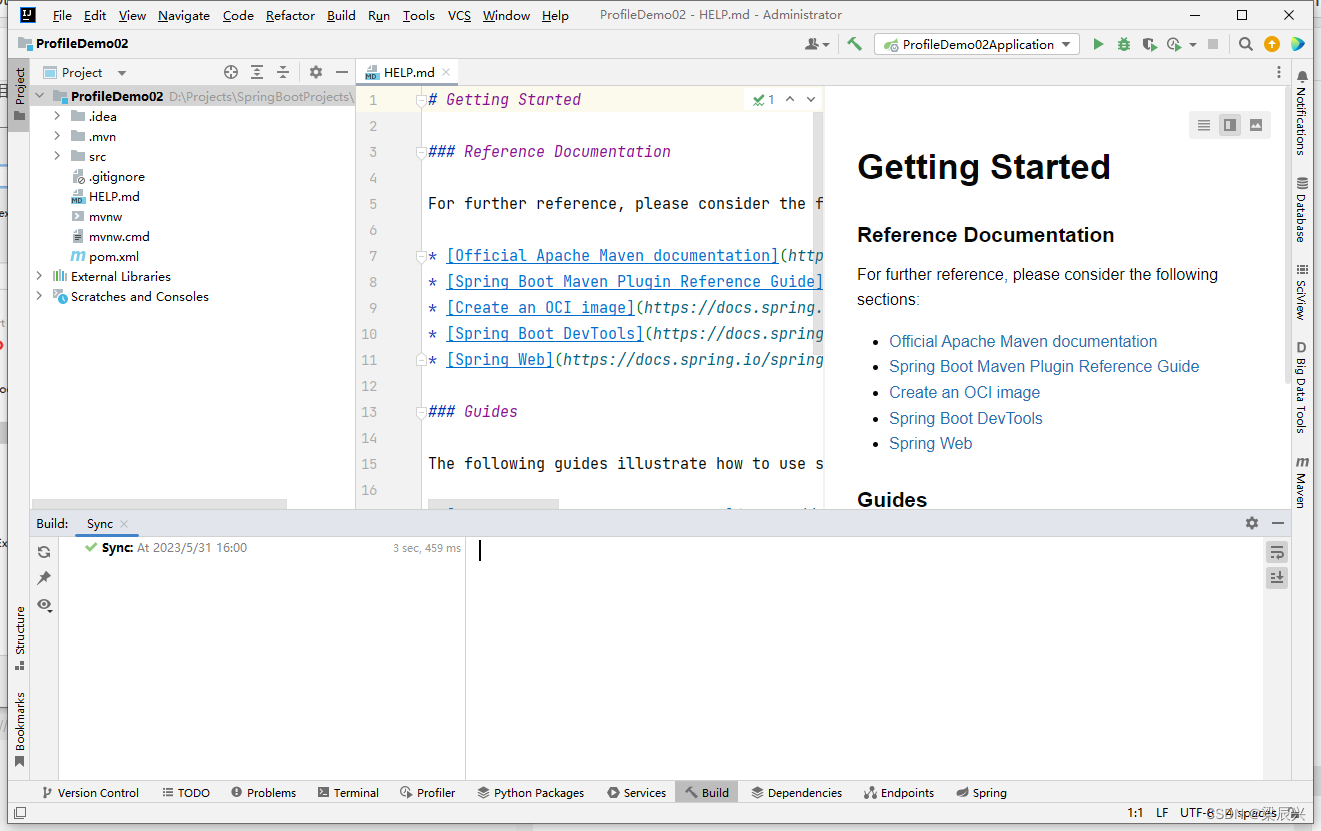 将项目进行热部署
将项目进行热部署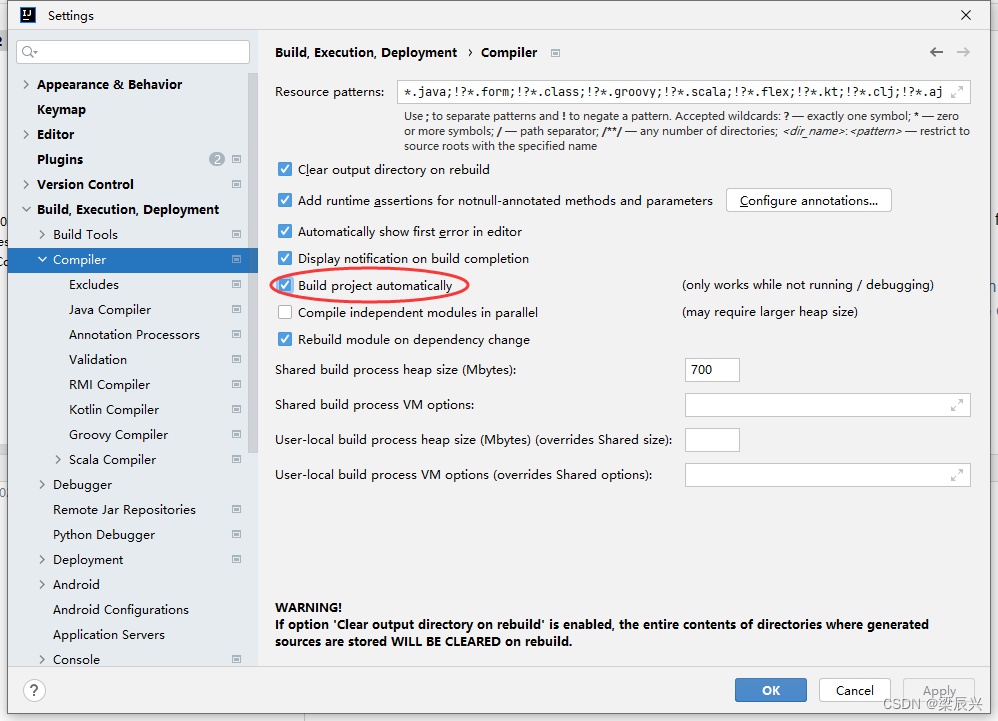
(二)创建数据库配置接口DatabaseConfig
在net.army.boot里创建config子包,在子包里创建DatabaseConfig接口
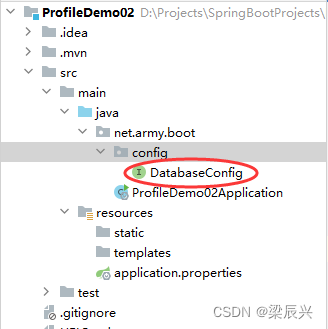
package net.army.boot.config; /** * 作者:梁辰兴 * 日期:2023/5/31 * 功能:数据库配置接口 */ public interface DatabaseConfig { void connect(); }(三)创建三个数据库配置实现类
1、创建数据库配置实现类MySQLConfig
在net.army.boot.config包里创建impl子包,在子包里创建MySQLConfig类
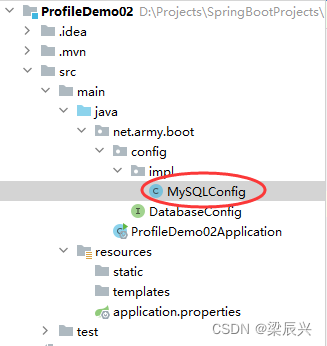
package net.army.boot.config.impl; import net.army.boot.config.DatabaseConfig; import org.springframework.context.annotation.Configuration; import org.springframework.context.annotation.Profile; /** * 作者:梁辰兴 * 日期:2023/5/31 * 功能:MySQL数据库配置实现类 */ @Configuration // 标识为配置类 @Profile("mysql") // 指定使用环境名称 public class MySQLConfig implements DatabaseConfig { @Override public void connect() { System.out.println("项目使用MySQL数据库环境~"); } }2、创建数据库配置实现类OracleConfig
在net.army.boot.config.impl包里创建OracleConfig类
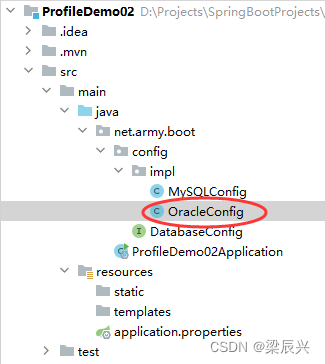
package net.army.boot.config.impl; import net.army.boot.config.DatabaseConfig; import org.springframework.context.annotation.Configuration; import org.springframework.context.annotation.Profile; /** * 作者:梁辰兴 * 日期:2023/5/31 * 功能:Oracle数据库配置类 */ @Configuration // 标识为配置类 @Profile("oracle") // 指定使用环境名称 public class OracleConfig implements DatabaseConfig { @Override public void connect() { System.out.println("项目使用Oracle数据库环境~"); } }3、创建数据库配置实现类SybaseConfig
在net.army.boot.config.impl包里创建SybaseConfig类
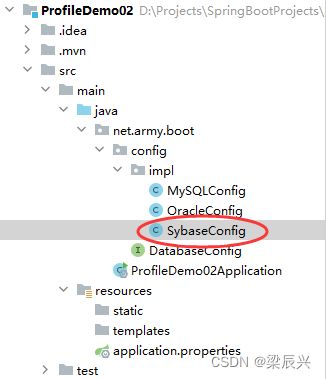
package net.army.boot.config.impl; import net.army.boot.config.DatabaseConfig; import org.springframework.context.annotation.Configuration; import org.springframework.context.annotation.Profile; /** * 作者:梁辰兴 * 日期:2023/5/31 * 功能:Sybase数据库配置类 */ @Configuration // 标识为配置类 @Profile("sybase") // 指定使用环境名称 public class SybaseConfig implements DatabaseConfig { @Override public void connect() { System.out.println("项目使用Sybase数据库环境~"); } }(四)在全局配置文件里设置使用环境
在全局配置文件application.properties里配置使用环境
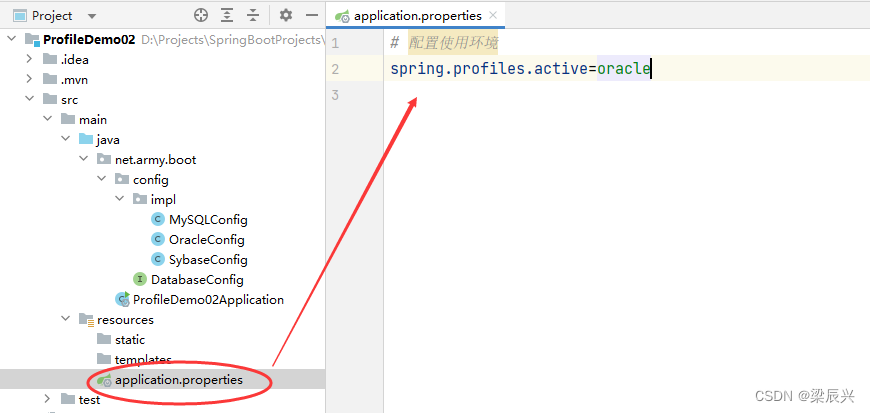
(五)打开测试类,编写测试方法
打开自带的测试类ProfileDemo02ApplicationTests
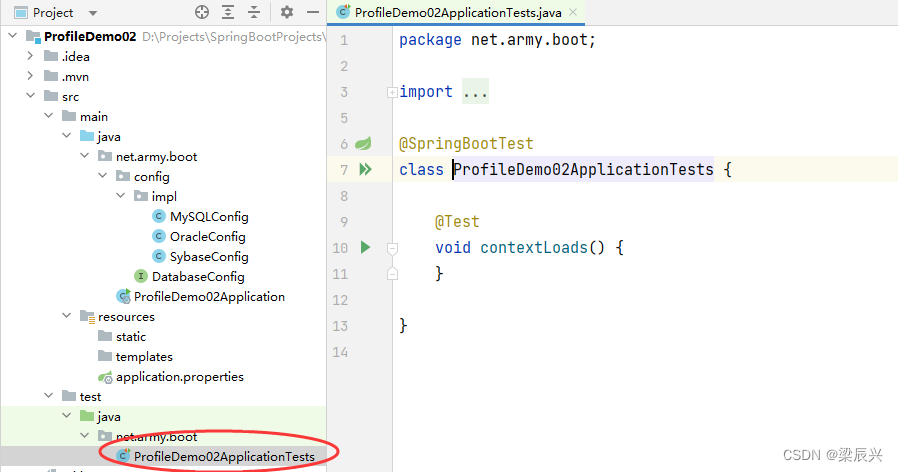
注入数据配置实体,调用数据库配置实体的方法
package net.army.boot; import net.army.boot.config.DatabaseConfig; import org.junit.jupiter.api.Test; import org.springframework.beans.factory.annotation.Autowired; import org.springframework.boot.test.context.SpringBootTest; @SpringBootTest class ProfileDemo02ApplicationTests { @Autowired // 注入数据库配置实体 private DatabaseConfig databaseConfig; @Test void contextLoads() { // 调用数据库配置实体的方法 databaseConfig.connect(); } }(六)运行测试方法,查看结果
运行contextLoads()测试方法,查看结果

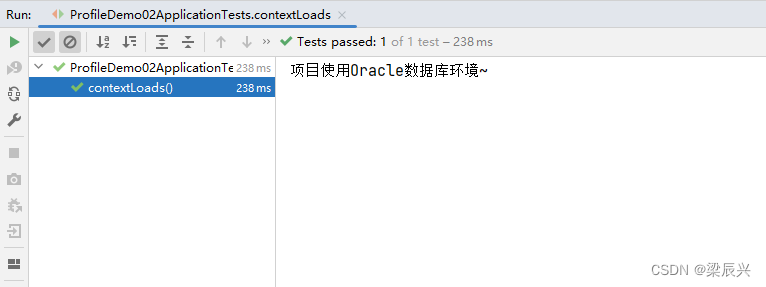
练习
1、设置使用环境 - MySQL数据库环境,并测试
2、设置使用环境 - Sybase数据库环境,并测试
四、随机值设置以及参数间引用
(一)创建Spring Boot Web项目RandomSetDemo
使用Spring Initializr模板创建Spring Boot项目
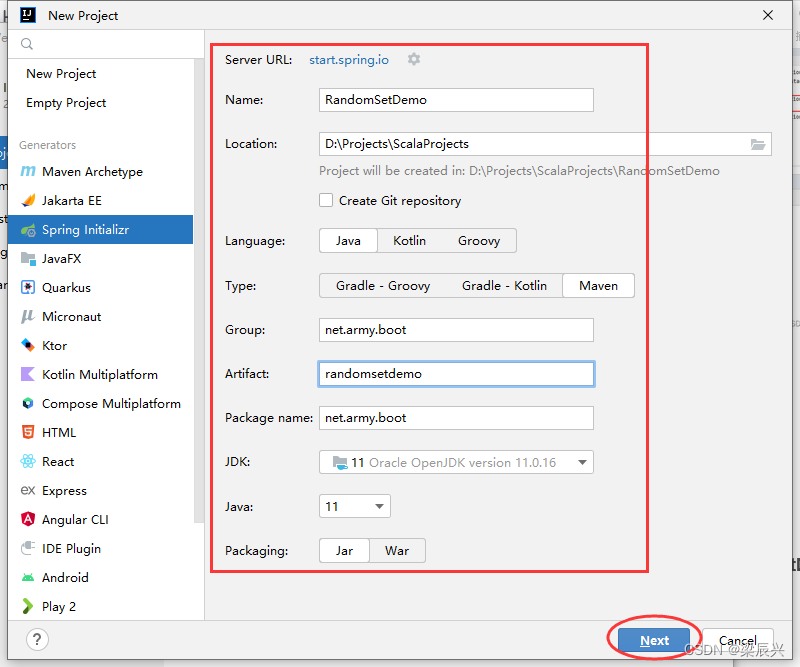
单击【Next】按钮,选择Spring Boot版本,添加相关依赖
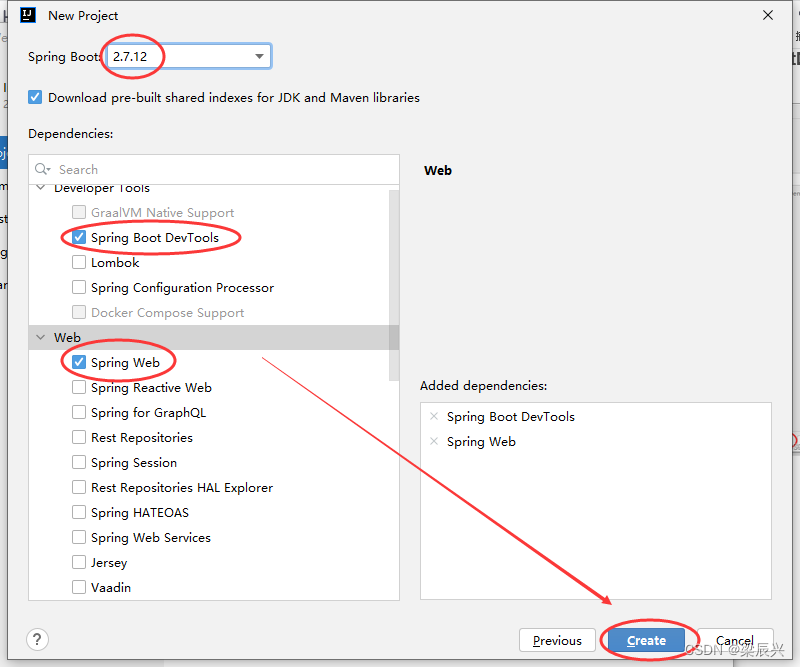
单击【Create】按钮
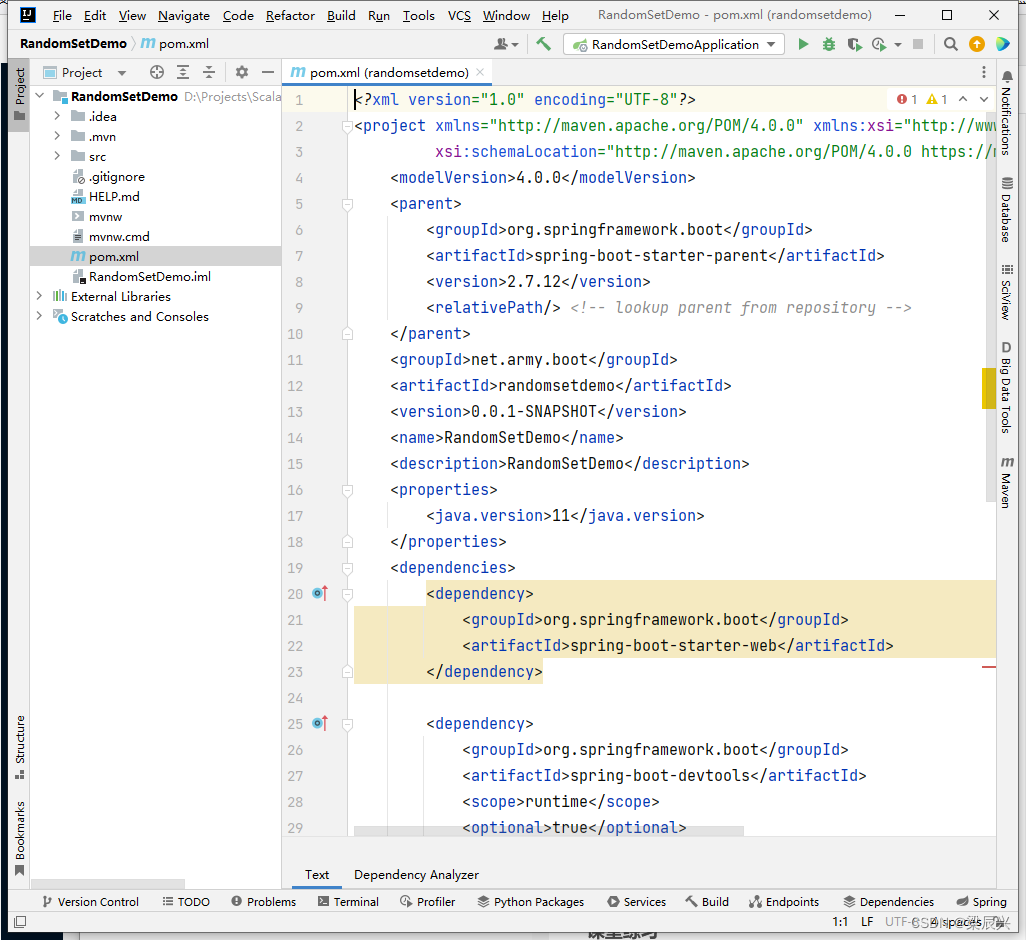
(二)在全局配置文件里配置随机值
在application.properties文件里配置
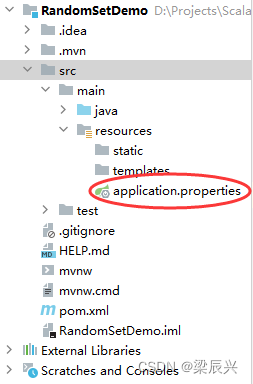
#一个随机值 lzy.value=${random.value} #一个随机整数 lzy.integer=${random.int} #一个长整型随机数 lzy.long=${random.long} #获取一个随机UUID值 lzy.uuid=${random.uuid} #小于10的随机整数 lzy.number.less=${random.int(10)} #随机产生1024至65535之间的数 lzy.number.range=${random.int[1024,65535]}(三)在测试类里测试配置的随机数
打开自带的测试类 - RandomSetDemoApplicationTests
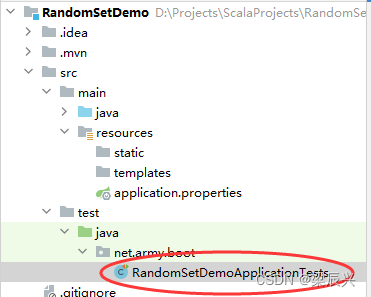
1、测试随机数my.number
注入配置文件里的属性
输出配置文件里的属性
package net.army.boot; import org.junit.jupiter.api.Test; import org.springframework.beans.factory.annotation.Value; import org.springframework.boot.test.context.SpringBootTest; @SpringBootTest class RandomSetDemoApplicationTests { // 注入配置文件里的随机值 @Value("${lzy.value}") private String value; @Test public void testRandomValue() { // 输出配置文件里的随机值 System.out.println("随机值:" + value); } }运行testRandonValue()方法,查看结果
 大家可以看到,产生的是32位的十六进制数对应的字符串,思考一下,能否将其变成128位的二进制串?
大家可以看到,产生的是32位的十六进制数对应的字符串,思考一下,能否将其变成128位的二进制串?2、测试随机整数my.integer
注入配置文件里的属性
输出配置文件里的属性
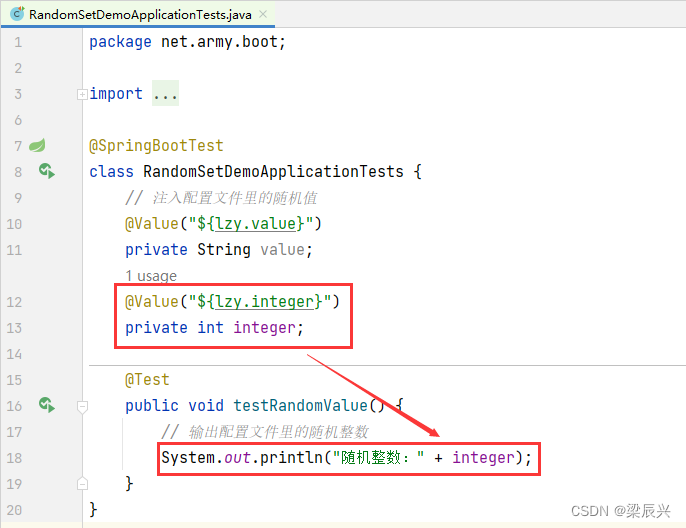
运行testRandomInteger()方法,查看结果
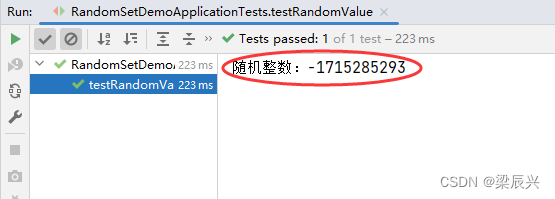
再运行testRandomInteger()方法,查看结果

练习
1、测试长整型随机数my.long

2、测试随机UUID值my.uuid

3、测试小于10的随机整数my.number.less


4、测试1024至65535之间的随机整数my.number.range

(四)演示参数间的引用
在appication.properties文件里,后定义的属性可引用前面定义的属性
定义三个属性year、month和day
定义属性user.name
定义属性user.birthday,引用属性year、month和day
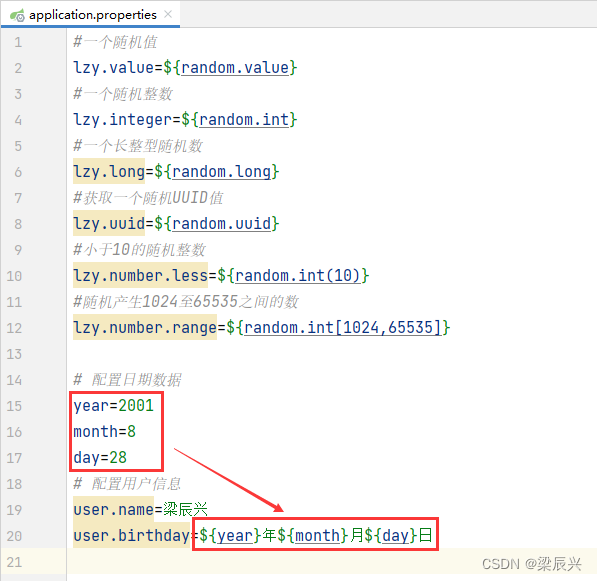
# 配置日期数据 year=2001 month=8 day=28 # 配置用户信息 user.name=梁辰兴 user.birthday=${year}年${month}月${day}日在测试类里编写testUser()方法
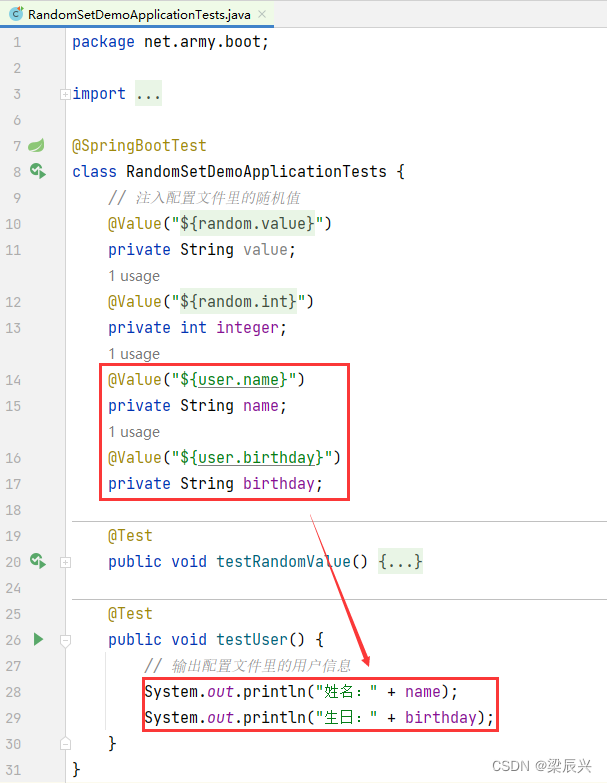
运行testUser()方法,查看结果
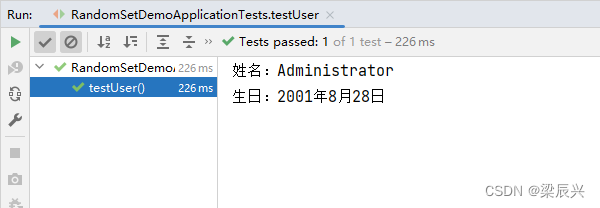
有点问题,明明在配置文件里,user.name=梁辰兴,但结果并非如此,原因何在?
user.name得到是系统用户名,而不是配置文件里定义的用户名。
修改配置文件,不使用user前缀,改用person前缀
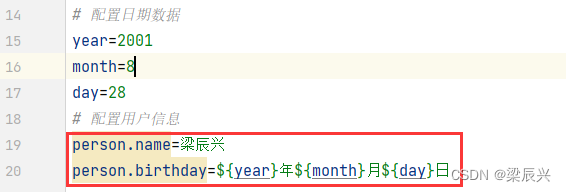
修改测试代码
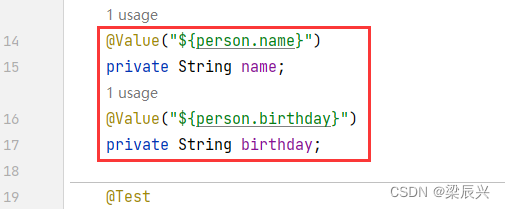
运行testUser()方法,查看结果















